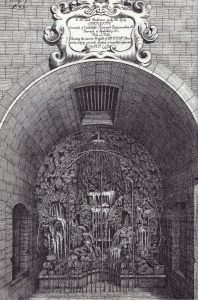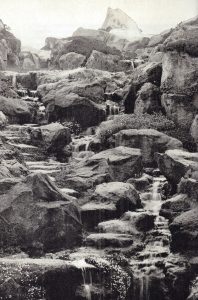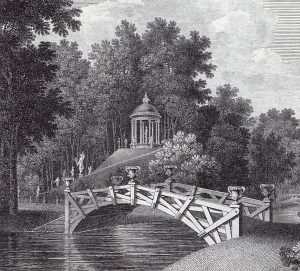a review by James Stevens Curl

English Garden Eccentrics: three hundred years of extraordinary groves, burrowings. mountains and menageries
by Todd Longstaffe-Gowan
London: Paul Mellon Centre for Studies in British Art, 2022
392 pp., 200 b&w and col. illus., £30.00
ISBN: 978-1-913107-26-0 hardback
Gardens were often the means by which ideas, emotions, and even the personalities of their creators could be encapsulated and expressed. The book describes and illustrates some extraordinary gardens laid out in England from the 17th to the early 20th century by individuals identified by Longstaffe-Gowan as ‘eccentrics’, among whom is included William John Cavendish-Bentinck-Scott (1800-79—5th Duke of Portland from 1854), known as ‘The Burrowing Duke’ because of the ‘gorgeous specimen of perverted ingenuity’ expressed in the series of tunnels and undergound rooms at Welbeck Abbey, Nottinghamshire (begun c.1860), illuminated by thousands of gas-jets, heated by hot air, and provided with tramlines by which food was transported from the kitchens. However, the Duke’s peculiarities were also manifest at Harcourt House, Cavendish Square, London, where he erected (1862) enormous metal-and-glass screens on the northern and southern sides of his garden, to conceal it. Even odder, the Duke had a short tunnel constructed to enable staff to traverse the garden without being seen. Some have suggested that Kenneth Grahame (1859-1932) based his ‘Mr Badger’ in The Wind in the Willows (1908) on the ‘Burrowing Duke’: after all, Badger inhabited ‘long tunnel-like passages branching, passages mysterious and without apparent end’, and Mole (another burrower) found Badger’s sett ‘comfortable and home-like’. Badger opined that there was ‘no security, or peace and tranquillity, except underground’.

One of the strangest chapters in this excellent book concerns the weird encrustation of a house that stood at the corner of Oakley Street and Upper Cheyne Row, Chelsea, and the cluttered 4-acre garden, filled with statuary and weather-beaten knick-knacks, created by John

Samuel Phené (1822-1912), architect and antiquary. Phené, of Huguenot descent, also claimed Phœnician and other ancestry, and travelled widely: he even followed carefully the various places in Byron’s Childe Harold’s Pilgrimage, and retraced the steps of St Paul in his missionary journeyings. He seems to have been well-connected, for when elected a Fellow of the Royal Institute of British Architects (1872) his supporters were Thomas Henry Wyatt (1807-80), Sir William Tite (1798-1873), and Sydney Smirke (1797-1877), but the façade he designed on the Cheyne Row front was bizarre in the extreme, almost nightmarish in its indiscriminate eclecticism. The rather sad garden, with its crumbling figures, fragments of mediæval masonry, was little short of being a mélange of incongruities in chaotic disarray, a garden of mildewed fragments.

Then there was the English take on the Garden of Eden in suburban Bedford created by Mabel Barltrop (1866-1934), identified in 1919 as ‘Shiloh’, the messenger and daughter of God whose appearance was foretold by Joanna Southcott (1750-1814), hailed in 1966 by the Marxist E.P. Thompson (1924-93) as England’s ‘greatest prophetess’ of Millennial phenomena. Barltrop was given the name ‘Octavia’ as the 8th prophetess of the Southcottian line, and appointed 12 female ‘apostles’ from her followers. Her group, initially called The Community of the Holy Ghost, became the Panacea Society, which shared a group of terrace-houses and communal gardens in and around Albany Street in Bedford, believing their properties comprised the site of the original Garden of Eden, and that when Jesus Christ turned up there, the world would become again a beautiful garden studded with jewels. Unlike most of the eccentrics in this amusing tome, who drew on exotic models as their sources for elaboration in their gardens, ‘Octavia’ borrowed hers from that with which she was familiar—the Edwardian suburban garden. A weeping ash-tree behind her house became the Yggdrasil of Norse mythology, the symbol of cosmic unity, around which members of the Panacea Society could dance, and the garden-shed became the chapel. As Britain’s destiny was to become the ‘New Jerusalem’, its new Garden of Eden had to be recognisable. Longstaffe-Gowan is excellent on this curious business, a new Paradise in Bedfordshire, maintaining a sober tone throughout.


He gives us descriptions and illustrations of many wonderful things, such as the astonishing 17th-century Grotto at Enstone, Oxfordshire, a ‘rare and admirable’ creation comprising a ‘fayre Chamber’ with a ‘neat Garden adioyning to itt’, complete with water-works, cascades, curiosities, and musical chirpings, created for Thomas Bushell (c.1600-74), former secretary to Francis Bacon (1561-1626). I used to live not far from Enstone, and I noticed on the front of a cottage opposite the former Manor House some stone details that must have been recycled from what was once known as The Enstone Marvels, but no other traces of that wondrous confection seem to survive.
Then there was the miniature copy of ‘Swiss Glaciers’ created in rockwork by Lady Broughton (born Elizabeth Egerton in 1771) from the 1820s at Hoole House, Cheshire . I first became aware of this miniature Alpine landskip in the works of John Claudius Loudon (1782-1843), where the gardens were

described and illustrated by that great Scots polymath, and the American landscape-gardener, Andrew Jackson Downing (1815-52), in his A Treatise on the Theory and Practice of Landscape Gardening (1841), waxed lyrical in his descriptions of Lady Broughton’s ‘imitation of the hills, glaciers, and scenery of a passage in Switzerland’. All traces of this garden have vanished, and the house is now an hotel in Outer Chester. Alpinism recurred at Friar Park, near Henley-on-Thames, Oxfordshire, created by Frank Crisp (1843-1919), which included a miniature Matterhorn the slopes of which were ‘mantled with snow’ (actually pulversised Derbyshire spar). Crisp, clad in frock-coat and top hat, delighted to show visitors the park with its ‘sham Swiss mountains and passes’ and ‘elaborate caves and underground lakes lit up with electricity and festooned with artificial … spiders and other monsters’. The garden was restored by the former Beatle, George Harrison (1943-2001), from the 1970s, despite a stern injunction to readers of Country Life in the 1920s that ‘any inclination to re-create miniature Matterhorns crowned with chamois, Edelweiss and the rest should be sternly suppressed’.

Perhaps even odder were the gardens at Lamport Hall, Northamptonshire, formed by Sir Charles Edmund Isham, 10th Baronet (1819-1903), who had embraced teetotalism, vegetarianism, homeopathy, and ‘psychic science’. Isham’s creations included bowers of box and the Eagle Walk flanked by 72 Irish yews, clipped and shaped by Isham himself. Near the end of this Walk were three huge cages, once occupied by a pair of eagles and a horned owl. But it was the enormous rockery, clad with an abundance of flowering plants, which attracted most attention from visitors: with its ‘deep recesses, bold protrusions, … and endless varieties of rock and alpine plants’ it was noteworthy enough, but it was also inhabited by miniature figures of gnomes or fairy miners at work in the caves and crevices, though some appeared to be on strike.

Even odder was a somewhat unnerving life-size painted terracotta figure of a young woman seated beside a watering-can: shortly after her arrival in the garden she was presented with a gorgeous hat and a diamond ring.

Among other curiosities in this intriguing book were the clipped yews in four ancient Middlesex churchyards: those at St Mary the Virgin, East Bedfont, Hatton Road, Feltham, remain pruned and in good condition. And there was the creation of that ‘maddest of all the mad Englishmen’, Charles Stanhope (1780-1851), 4th Earl of Harrington from 1829, better-known by his courtesy title, Viscount Petersham. After marrying (1831) his mistress, the actress Maria Foote (1797-1867), who was too notorious to appear in Polite Society, Petersham lived in seclusion at Elvaston Castle, Derbyshire, where he devoted himself to Gothicising the house and creating a ‘Modern Palagonia’ contrasting with the rather dull countryside in which the property was situated. This involved transplanting mature trees, including yews and cedars, which attracted the attention of Loudon, who wrote up the place in the Gardener’s Magazine. Elvaston is now owned and managed by Derbyshire County Council as one of the first country parks in England. There was more topiary at Witley Court, Worcestershire, created for Rachel Anne Gurney (1867-1920—Countess of Dudley from 1891), but that has been destroyed.




There is more, much more, in this cornucopia of exotica. Lady Dorothy Nevill (1826-1913) and her ephemeral Exotic Groves; the ‘Vivarium’ of Dr Joshua Brookes (1761-1833) at Blenheim Street, Soho (long gone); sundry creations by that curious figure, the antiquary and natural philosopher William Stukeley (1687-1765), at Stamford and Grantham in Lincolnshire, and Kentish Town, London; the grotto and grounds of Walton Hall, Walton, Wakefield, West Yorkshire, laid out for Charles Waterton (1782-1865); the Sublime landskips of Hawkstone Park, Shropshire, which stimulated a ‘Kind of Turbulent Pleasure between Fright and Admiration’ in those who visited it, created for Sir Rowland Hill, Bt. (1705-83), which included a Grotto and a wax hermit in his cell, complete with skull; West Wycombe Park, Buckinghamshire, where Sir Francis Dashwood, Bt. (1708-81-11th Baron Le Despencer from 1763), created gardens and fabriques some of which were of a ‘lewd nature’; and at Denbies, Ranmore Hill, Surrey, Jonathan Tyers (1702-67), from 1734 drew on Milton’s Il Penseroso (1645) and more especially on Night Thoughts (1742-5) by Edward Young (1683-1765), to fashion one of the wittiest dismal demesnes of Georgian England (see ‘The Tomb and the Garden: The Influence of Young’s Night Thoughts’ in The Geogian Group Journal xxv [2017] 185-206). Tyers, of course, is remembered more for his celebrated Vauxhall Gardens, London, where the presiding spirit of frivolity owes more to Milton’s L’Allegro. But a brief review can only be an indication of the many delights that lie within such a volume as this.

Finally, the publishers are to be congratulated on a handsome production, decently printed on good paper, and stoutly bound. I do wonder, however, when books are printed in China: there are plenty of competent printers in the islands of what some purists now refer to as ‘The Atlantic Archipelago’, so using outfits that undercut them at the moment may put many old-established firms out of business. What then?
First published in The Critic.
Among Professor James Stevens Curl’s many books are Making Dystopia: The Strange Rise and Survival of Architectural Barbarism (Oxford University Press 2028, 2019) and Spas, Wells, & Pleasure-Gardens of London (Historical Publications 2010). In 2019 he was honoured with an Arthur Ross Award for Excellence in the Classical Tradition for History & Writing by the Institute of Classical Architecture & Art, USA.
- Like
- Digg
- Del
- Tumblr
- VKontakte
- Buffer
- Love This
- Odnoklassniki
- Meneame
- Blogger
- Amazon
- Yahoo Mail
- Gmail
- AOL
- Newsvine
- HackerNews
- Evernote
- MySpace
- Mail.ru
- Viadeo
- Line
- Comments
- Yummly
- SMS
- Viber
- Telegram
- Subscribe
- Skype
- Facebook Messenger
- Kakao
- LiveJournal
- Yammer
- Edgar
- Fintel
- Mix
- Instapaper
- Copy Link









